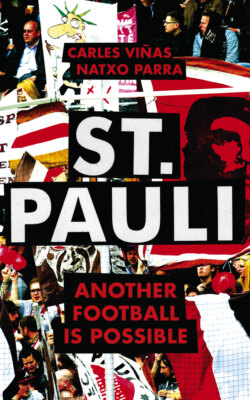Читать книгу St. Pauli - Carles Vinas - Страница 18
На сайте Литреса книга снята с продажи.
6 The New Millerntor Stadium
ОглавлениеIn the 1960s the club went through several changes while the league system was being restructured. The most important, beyond any doubt, was the building of its new stadium. In 1963 Hamburg hosted, as it had done ten years earlier, a new edition of the Internationale Gartenschau Ausstellum (International Gardening Exhibition). To accommodate the exhibition grounds the Town Hall requisitioned the old St. Pauli stadium – built in 1946 and located opposite the old fire station. In exchange, the municipal authorities backed the construction of a new sports complex to be located a few hundred metres from the old stadium. This would be in the Heiligengeistfeld, FC St. Pauli’s historic epicentre, although moving the stadium to a municipal park elsewhere in the city had been considered at the beginning.
By 1960, work had started on a venue with a capacity of 32,000 spectators, later reduced to 20,269. The reduction was due to the pitch’s lack of a drainage system, leading to a series of interventions that did not end until the stadium’s renovation in 2007. Despite these hindrances, FC St. Pauli’s new Millerntor stadium was eventually unveiled on 29 July 1961. This was for a friendly match in which the braun-weiss team played the Bulgarian CDNA Sofia (later CSKA Sofia), with the home side winning 7–4.
At that time the Millerntor stadium was the most modern sports complex in the city. Yet the club needed to overcome the aforementioned problem of pitch drainage, worsened by the city’s high rainfall levels. To do so those in charge of looking after the turf chose to make several hundred holes in it and fill them with sand just before a home match against VFV Borussia Hildesheim (on 21 February 1962). The measure was repeated in May but with unwanted results. Clearly far from overcoming the hurdle, the pitch became a sandpit and object of ridicule. Unsurprisingly the joke on the terraces was that the team had become Sand Pauli. When player Heinz Deininger became injured – breaking his ankle during a friendly – due to the pitch’s poor state, the club’s directors reacted angrily, refusing to return to the venue unless the required drainage took place and the grass was in the required condition. For this reason, in June 1962, after reaching an agreement with the local authorities, St. Pauli moved its matches to the Hoheluftstadion – owned by SV Victoria – which was then the oldest ground still standing in the city. The brown-and-white team’s exile did not end until 10 November 1963. That day, the club’s players returned to the Millerntor Stadion to take on VfL Wolfsburg.
The new stadium’s inauguration coincided with a rise in crime in the district, which was linked to the growing prostitution and entertainment industries. It was then that some local gangsters became well known. One was Wilfrid ‘Frieda’ Shultz, the Godfather of St. Pauli, who went from being a warehouse assistant to owning restaurants in the Reeperbahn and being a partner in hotels and discotheques. In 1959 he took over gambling in the area after the US Mafia helped remove the Italians running a protection racket. In St. Pauli, Frieda’s word was gospel. He was tried on 25 occasions but was given only four minor convictions and had good relations with the city’s upper classes. In the 1980s, when drugs burst into the neighbourhood, he retired, dying of cancer in 1990. His criminal gang had to coexist with others. These included the GMBH cartel: a ring of pimps (Gerhard Glissmann, Michael ‘Mischa’ Luchting, Walter Beagle Vogeler and Harald Voerthman). They operated in St. Pauli in the 1970s and 1980s, controlling brothels, peepshow venues, restaurants, casinos and clubs. Other gangs were the Nutella Bande, led by ‘Tommy Karate’ Born, who took on the GMBH over controlling prostitution; Das Chicago, the third St. Pauli gang which became prominent in the 1980s due to the rise of cocaine; the gunmen ‘Wiener’ Peter and Werner Pinzer – the St. Pauli assassin; or bikers groups such as the Hamburg section of the Hell’s Angels (which was shut down by the police in the 1980s). These groups formed alliances or fought between them from the 1970s, and the gang warfare continued into the following decade over control of weapons and drugs such as cocaine.
